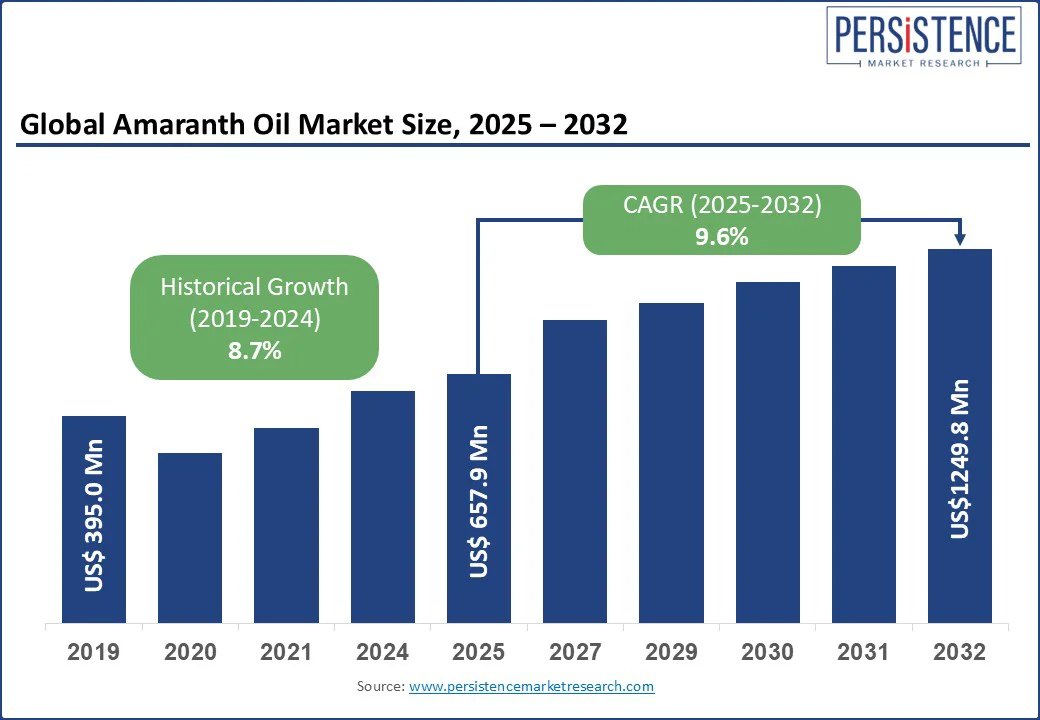ID: PMRREP3170| 185 Pages | 1 Aug 2025 | Format: PDF, Excel, PPT* | Chemicals and Materials

The global Amaranth Oil Market size is likely to be valued at US$ 657.9 Mn in 2025 and is estimated to reach US$ 1249.8 Mn in 2032, growing at a CAGR of 9.6% from 2025 to 2032.
The global amaranth oil market, a vital segment of the natural oils industry, is experiencing robust growth driven by increasing demand for organic amaranth oil in cosmetics, health supplements, and pharmaceutical oils. Amaranth oil, extracted through methods such as supercritical CO2 extraction, cold pressing, and organic solvent (hexane) extraction, is prized for its high squalene content and antioxidant properties, making it a key ingredient in personal care products and dietary supplements.
The Amaranth Oil market’s expansion is fueled by rising consumer preference for sustainable oils, growing health awareness, and advancements in extraction technologies. Applications in aromatherapy oils and pharmaceuticals further boost demand. Asia Pacific and North America dominate the amaranth oil market, with significant contributions from India, the U.S., and China, supported by strong agricultural infrastructure and consumer demand for natural products. The industry is highly competitive, with key players focusing on innovation to enhance extraction efficiency and meet regulatory standards for organic products.

The material’s unique properties and expanding applications are boosting the market.
The amaranth oil market is experiencing robust growth driven by the material’s exceptional properties and increasing range of applications. Amaranth oil exhibits high squalene content, omega fatty acids, and antioxidant properties, making it ideal for advanced applications across diverse sectors. Its use is expanding in cosmetics and personal care, dietary supplements, pharmaceuticals, and aromatics, where natural and health-promoting ingredients are crucial. For instance, A USDA study highlights amaranth oil’s rich squalene content up to 6-8% and its growing use in nutraceutical, cosmetic, and pharmaceutical industries due to its antioxidant, immune-stimulating, and skin-smoothing properties. As industries pursue eco-friendly and sustainable solutions, amaranth oil offers significant advantages over conventional oils.
The cosmetics and personal care industry’s rapid growth fuels amaranth oil demand.
Due to its skin-identical squalene and UV-protective properties, amaranth oil is integral to developing high-performance skincare products, haircare formulations, and anti-aging solutions. For instance, A PubMed-NCBI study, originating from government-supported research, evaluated the protective effect of Amaranth seed oil on human skin fibroblasts exposed to UVA radiation. It confirms that amaranth oil provides effective protection both pre- and post-UVA exposure, highlighting its role in UV-protective skincare formulations global cosmetics market creates a substantial market for amaranth oil.
Among extraction methods, cold pressing leads due to its cost-effectiveness, preservation of nutritional content, and suitability for large-scale amaranth oil production. It is widely adopted in industries such as cosmetics and dietary supplements.
Supercritical CO2 extraction is the fastest-growing method, driven by its ability to produce high-purity, residue-free oil. This technique is gaining traction in pharmaceuticals and premium cosmetics despite higher operational costs. Applications such as herbal therapeutic oil and muscle pain massage oil benefit from these extraction methods. Solvent-free extraction technologies are also entering the Amaranth Oil market, which results in rising demand for clean-label production.
Among packaging types, HDPE Carboys lead due to their cost-effectiveness and suitability for bulk storage, particularly in industrial applications such as pharmaceuticals. HDPE Carboys held a significant market share by volume.
Aluminum Bottles, however, are the fastest-growing packaging type, fueled by increasing demand in niche applications such as premium cosmetics and aromatics.
Among categories, conventional amaranth oil leads the industry due to its lower cost and broad application scope, particularly in dietary supplements and industrial uses.
The organic category, however, is the fastest-growing, fueled by rising demand for eco-friendly and health-conscious products such as organic cosmetics and supplements. Ayurvedic medicine and herbal therapy are expected to see expanded use of these oils.
North America holds a substantial share of the global amaranth oil market in 2024, led by the U.S. due to its strong cosmetics, nutraceutical, and personal care sectors. The U.S. Amaranth Oil Market growth is driven by:
The global amaranth oil market is highly competitive, with companies focusing on research and development (R&D) to develop sustainable oils and advanced extraction methods, such as supercritical CO2 extraction. Strategic partnerships, such as FLAVEX Naturextrakte’s collaboration with cosmetics brands, enhance market penetration. Firms such as Sunsoil Pvt. Ltd. and Ziani Organic Oils are expanding in the Asia Pacific, while O&3 Limited integrates eco-friendly packaging for premium markets.
It’s expected to grow from roughly US$ 657.9 million in 2025 to US$ 1249.8 million by 2032, with a CAGR of 9.6%.
The cold pressing process leads the sector with over 50% share in 2024 and is the fastest-growing segment, driven by demand for sustainable oils.
Cosmetics and personal care dominate the industry, accounting for over 50% of demand, driven by its use in personal care ingredients.
North America (especially the U.S.) leads globally with around 40% share, while the Asia Pacific shows the fastest regional growth in health-conscious product demand.
Leading suppliers include FLAVEX Naturextrakte, Ziani Organic Oils, Sunsoil Pvt. Ltd., O&3 Limited, and Amrtamyawellness, focusing on innovative natural oils solutions.
|
Report Attribute |
Details |
|
Historical Data/Actuals |
2019 - 2024 |
|
Forecast Period |
2025 - 2032 |
|
Market Analysis |
Value: US$ Mn |
|
2025 (E) |
US$ 657.9 Mn |
|
2032 (F) |
US$ 1249.8 Mn |
|
Historical CAGR |
7.5% |
|
Projected CAGR |
9.6% |
|
Geographical Coverage |
|
|
Segment Coverage |
|
|
Competitive Analysis |
|
|
Report Highlights |
|
|
Customization and Pricing |
Available upon Request |
By Extraction Type
By Packaging Type
By Category
By Application
By Region
Delivery Timelines
For more information on this report and its delivery timelines please get in touch with our sales team.
About Author